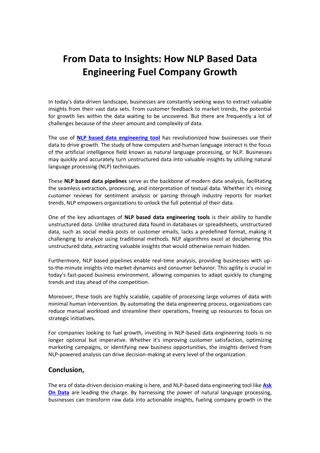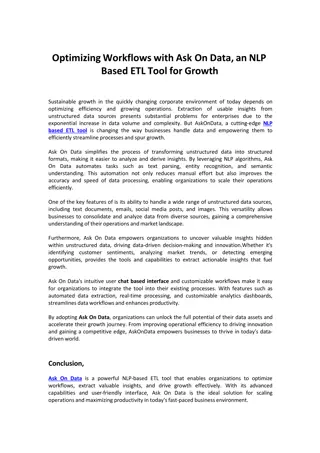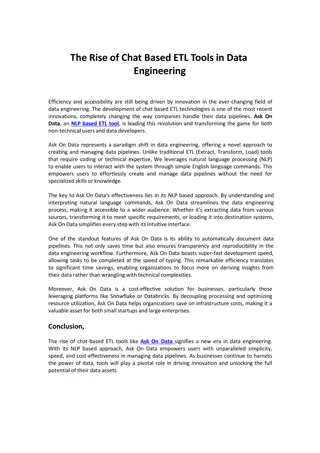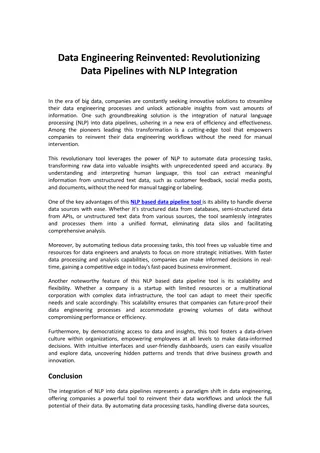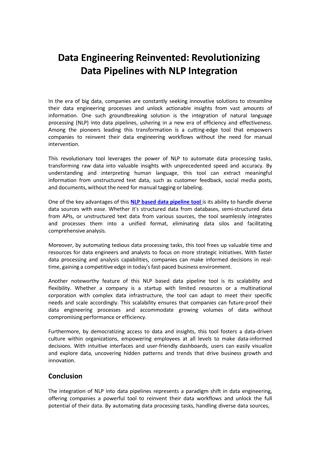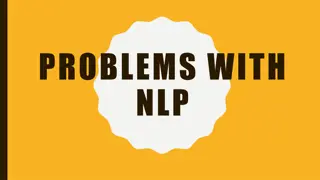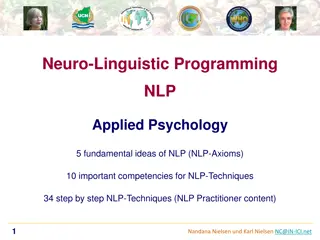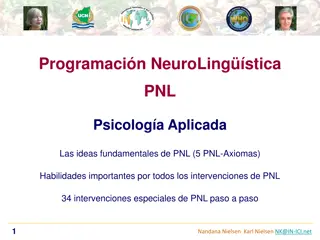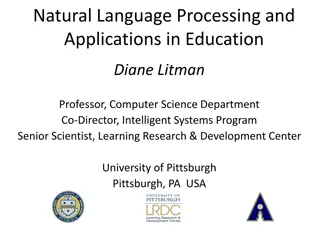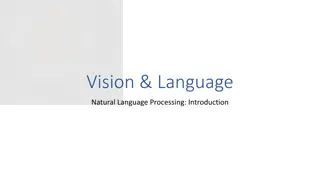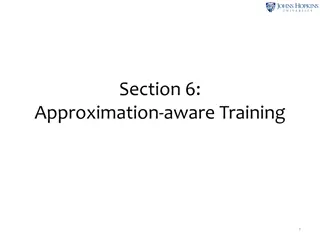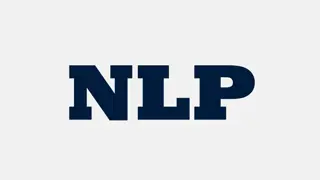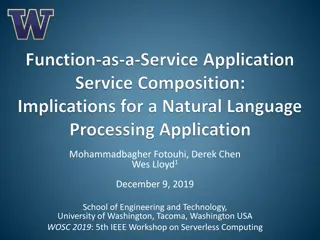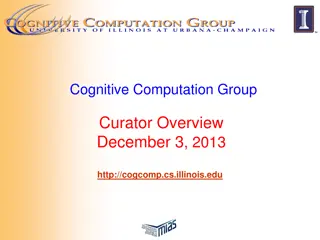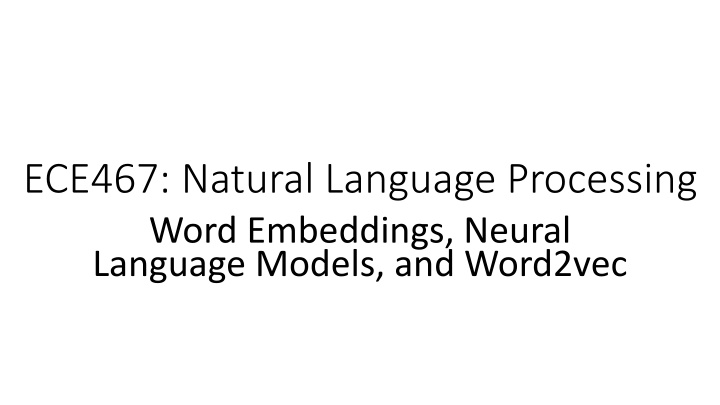
Understanding Word Embeddings and Neural Language Models
Explore the evolution of word embeddings in NLP, from traditional methods like TF*IDF vectors and Latent Semantic Analysis to modern approaches such as word2vec and neural language models. Gain insights into creating vector representations of words and the significance of word embeddings in natural language processing.
Download Presentation

Please find below an Image/Link to download the presentation.
The content on the website is provided AS IS for your information and personal use only. It may not be sold, licensed, or shared on other websites without obtaining consent from the author. If you encounter any issues during the download, it is possible that the publisher has removed the file from their server.
You are allowed to download the files provided on this website for personal or commercial use, subject to the condition that they are used lawfully. All files are the property of their respective owners.
The content on the website is provided AS IS for your information and personal use only. It may not be sold, licensed, or shared on other websites without obtaining consent from the author.
E N D
Presentation Transcript
ECE467: Natural Language Processing Word Embeddings, Neural Language Models, and Word2vec
If you are following along in the book Chapter 6 of the textbook (current draft) is called "Vector Semantics and Embeddings" The chapter includes discussion of concepts such as conventional TF*IDF vectors to represent documents (we already covered that during a previous topic) We will start this topic by briefly discussing conventional methods of creating vector representations of words; this material is not from the textbook Sections 7.6 and 7.7 are about neural language models; we will cover this before word2vec Note that we already covered Sections 7.1 7.5 during out topic on feedforward neural networks Section 6.8 is about word2vec; we will cover this, and I also relied on the original word2vec papers (I have linked to these papers from the course website) Sections 6.9 6.10 also concern modern word embeddings; we will cover the material from these sections Section 6.11 is about biases in word embeddings; we will discuss this as part of a future topic In general, some of the material scattered throughout this topic comes form an earlier draft of the textbook An earlier draft of the 3rdedition of the textbook covered neural networks before word2vec Because of that, they were able to use neural networks to conceptually explain word2vec; we will discuss that, because I think it helps to intuitively understand how word2vec works
An Older Technique The representation of words as vectors, often called word embeddings, has played a significant role in revolutionizing the field of natural language processing (NLP) Before discussing techniques such as word2vec to produce word embeddings, I want to briefly discuss an older technique Latent semantic analysis (LSA) is a decades-old technique that produces vectors representing abstract concepts, based on a set of documents All text-based sequences (including documents, queries, and single words) can be represented as weighted sums of these concepts In theory, similar, or related, words/queries/documents should have similar representations When LSA is used in the context of information retrieval (IR), the approach is known as latent semantic indexing My own impression: LSA is very interesting, but at least when I was a graduate student, it didn t seem to lead to great results for the various NLP tasks to which it was applied
Revisiting the Term-document Matrix In a term-document matrix (which we learned about in a previous topic), rows represent words, and the columns represent documents The value in row i, column j, represents the weight of the ithword in the jthdocument of a corpus The weights are typically counts (i.e., the number of times the word appears in the document), but other weights could be used Here is a simplified example of a small term-document matrix (it is the same example we looked at during a previous topic): The matrix is generally sparse, since most words do not appear in most documents In practice, we typically use an inverted index to store the information (we also discussed this data structure during a previous topic)
Interpreting a term-document matrix We can think of each column as being a bag-of-words representation of the document (this concept was also mentioned during a previous topic) Additionally, we can also think of each row as being a representation of a word It seems reasonable to assume that similar words will occur in many of the same documents More generally, the distributional hypothesis predicts that words with similar semantic meaning will occur in similar contexts LSA involves the use of singular value decomposition (SVD) applied to the term-document matrix (or to a matrix related to it)
Semi-Modern Word Embeddings The vector representations of words created by approaches such as word2vec are often referred to as word embeddings Some sources refer to the vectors as word embedding vectors, word vectors, or just embeddings The idea is to create a d-dimensional vector, with a fixed d, for each word in a vocabulary Typically, d is in the range of 50 to 500 These word embeddings are learned from a corpus using an unsupervised learning approach The sorts of word embeddings we will learn about in this topic are static word embeddings This means that a single word embedding is learned for each word (or more generally token) in the training corpus, not taking context into account In the current slides, I've been sometimes referring to these as "semi-modern", because they are no longer used in most state-of-the-art systems We will see in future topics that embeddings can also be learned to represent subwords and that methods to produce contextual word embeddings (taking context into account) can be learned
Pre-word-embedding Neural Networks Consider neural networks (NNs) applied to NLP tasks (e.g., text categorization) without word embeddings As explained at the end of the previous topic, in conventional NLP, a typical approach would include an input node for every word in the vocabulary That is, if the size of the vocabulary were V, there would be V input nodes or units in the input layer of the neural network This would typically be a rather large input layer, by conventional standards The values of the inputs could be Boolean values, word counts, or TF*IDF weights This was a bag-of-words approach; the order of the words in the input document would not affect the input to the neural network Optionally, other input features could also be included, in addition to the words The rest of a conventional neural network would likely consist of one fully- connected hidden layer and an output layer
Problems with Pre-word-embedding NNs Problems with conventional (pre-word-embedding) NNs applied to NLP tasks include: There are a lot of weights between the inputs and the first hidden layer; this could lead to overfitting There is no simple way to incorporate word order into the methodology Incorporating bigrams or larger N-grams would blow up the number of input nodes much further (we'll discuss N-grams in a bit more detail shortly) Two very similar words would be represented by entirely different nodes Of course, stemming or other text normalization techniques could be used Still, any two distinct tokens either would be treated as identical or would be treated as completely different It is my impression that before word embeddings became popular in NLP, NNs achieved state-of-the-art results for very few, if any, NLP tasks
Advantages of Word Embeddings for NNs The number of input nodes is related to d, the dimension of the word embeddings For different tasks and architectures, the input might be one word embedding at a time or a fixed number of word embeddings at a time Consider a task such as sentiment analysis applied to one sentence at a time For convolutional neural networks (CNNs), the input typically consists of all the word embeddings from one padded sentence at a time (we will not discuss CNNs in this course) For recurrent neural networks (RNNs), typically one word embedding at a time is used as input, and the words are traversed in a sequence (we will learn about RNNs in a future topic) For transformers, the input typically consists of all the word embeddings from one padded sentence at a time (we will learn about transformers in a future topic) Similar (but non-identical) words will have similar word embeddings
Language Models and N-grams A language model is a model that assigns a probability to a sequence of text In conventional (pre-deep learning) NLP, N-grams were typically used for this purpose An N-gram is a sequence of N consecutive tokens (in conventional NLP the tokens were often words, but they can be subwords, characters, embeddings, etc.) Common N-grams include 2-grams (bigrams) and 3-grams (trigrams); single tokens can be called unigrams An N-gram model computes estimates of the probabilities of each possible final token of an N-gram given the previous N-1 tokens Chapter 3 of the textbook is titled, "N-gram Language Models", and I used to spend an entire topic on this Now, I am just going to spend a few minutes in class discussing how N-gram models can be trained and applied The previous edition of the book stated: " the N-gram model is one of the most important tools in speech and language processing"; this sentence has been dropped in the current edition (because it is no longer true) The February 2024 draft of the current edition of the textbook stated that N-gram models "are an important foundational tool for understanding the fundamental concepts of language modeling"; this sentence has also been dropped The current draft of the textbook states that "because n-grams have a remarkably simple and clear formalization, we use them to introduce some major concepts of large language modeling" The next two slides show examples of using N-gram models for natural language generation (NLG) NLG is an important component of several NLP applications including machine translation, summarization, chatbots, etc. Comparing the two examples demonstrates the importance of the training set Of course, we also see that N-grams do not work nearly as well for NLG as modern large language models
Neural Language Models To help explain the usefulness of word embeddings, we are going to start by examining neural language models (NLMs) In this topic, we will be looking at feedforward neural language models More modern neural language models would use recurrent neural networks or transformers (these architectures will be covered in future topics) We will consider a neural network architecture that considers three sequential words at a time and predicts the next word The next slide shows our first example of a neural language model Note that this figure is from an earlier draft of the textbook This current draft skips this version and starts with the architecture that we will look at second, but I think there are interesting points to make starting with the first version The slide after the figure discusses the example in more detail This example is doing something similar to what a conventional 4-gram model would do, but it is now a neural network that is predicting words, not an N-grams model
Notes About the First NLMs Architecture The projection layer, a.k.a. embedding layer, of the neural network consists of 3*d nodes, where d is the dimension of each word embedding vector In this example, the embedding layer is also the input layer to the NN For now, we are assuming that there is a known mapping from each word in the vocabulary to a word embedding for that word We'll talk more about how such a mapping can be learned later (word2vec is one such method) It is also possible to learn word embeddings for the current task (we'll see how to do when we look at our second example of an NLM), or to use contextual word embeddings (covered in a future topic) The output layer contains |V| output nodes, where V is the set of vocabulary words The output layer is a softmax layer; the output of the ithoutput node is interpreted as the probability that the ithvocabulary word is the next word The dimensions of the layers and weight matrices in the diagram are a bit confusing They are treating the layers as column matrices as opposed to row matrices, although they are not drawn that way This is fine, as long as they are consistent with the vector and weight matrices This figure is also simplified in that it is not considering the bias weights that would lead into the hidden layer (this simplification is typical in diagrams of neural networks)
Training the First NLM Assuming the existence of a fixed mapping between words and embeddings, we can train such a network using stochastic gradient descent and backpropagation Both of these concepts were discussed during our topic on feedforward neural networks Before training, the weights of the NLM are initialized to small random values In theory, we could then compute the ideal probability model for each N-gram and then train the model, but that is not what happens in practice In practice, we would loop through a large training corpus, and for each N-gram (4-gram, in this case) in the corpus, we do the following: We map the first n-1 words to embeddings and concatenate these to form the NN input For the output, we treat the probability of the actual word as 1, and all other probabilities as 0 The formula for the cross-entropy loss function becomes: L = -log P(wt| wt-1 wt-n+1) Looping through all the N-grams in the entire training set would be one epoch of training Multiple epochs would be applied, until there is some sort of convergence
Advantages of Neural Language Models No smoothing of probabilities is necessary; a softmax layer never outputs a 0 exactly The neural network has a good chance has of generalizing based on similar words to the current words The neural network has a good chance of predicting the next word after trigrams (or more general N-grams) that have never been seen Neural language models can generally handle longer N-grams compared to conventional language models In practice, neural language models (e.g., those using LTSMs or transformers) make much better predictions than conventional N-gram models In theory, we can evaluate a language model by multiplying together the predicted probabilities of words or tokens in documents from a test set In practice, we instead add log probabilities to avoid issues with finite precision, or we use a related metric such as perplexity (I'll briefly discuss this in class)
Using the NN to Learn the Embeddings By adding one additional layer to our network: The network can learn the word embeddings, as it learns how to predict the probabilities of the next words Such a network is learning embeddings specifically for the task of serving as a neural language model We will discuss later that word embeddings learned for one purpose can be useful for many other tasks as well The next slide shows an updated example of a neural language model that also learns the word embeddings; the following slide discusses the example in more detail This figure is from an earlier draft of the textbook, but a similar figure for the same example appears in the current draft I'm keeping the older version of the figure in these slides because its format is more consistent with the figure from the previous example Note that when static word embeddings are learned separately (as in the first NLM example), in practice, training a neural network is not the actual method used to learn such embeddings However, some NN architectures do learn word embeddings while learning the task that the embeddings are being used for (as in the second NLM example)
Notes About the Second NLMs Architecture The input layer now consists of three |V|-dimensional one-hot vectors, containing a single 1, representing (in this case) a specific word, and 0s everywhere else To get from the input layer to the embedding layer (a.k.a. projection layer), a set of shared weights is used to convert each one-hot vector to a word embedding vector That is, each one-hot vector at the input layer is being multiplied by the same weight matrix, E, to produce a word embedding in the embedding layer The columns of the E matrix represent the word embeddings that are being learned The big difference between the two NLM architectures we have discussed is that in the second example, E is being learned along with the rest of the network's weights The training of the updated network can proceed in a similar fashion to the last one, using stochastic gradient descent and backpropagation Before training, all weights including those in E are initialized to small random values For each N-gram of a large corpus, we concatenate N-1 one-hot vectors to form the input For the output, we treat the probability of the actual word as 1, and all other probabilities as 0 (the same as for the previous NLM) The loss function is the same as for the previous network: L = -log P(wt| wt-1 wt-n+1)
Advantages of Word Embeddings in General In Section 6.8 of the textbook, titled "Word2vec", they claim: "It turns out that dense vectors work better in every NLP task than sparse vectors." Next, they state, "While we don t completely understand all the reasons for this, we have some intuitions." Reasons they list (which are related to the advantages of using word embeddings with neural networks that we looked at earlier) include: It is easier to use dense vectors as features for machine learning systems (i.e., they lead to fewer weights, as we previously mentioned) They may help to avoid overfitting (this is related to fewer weights) The book says they "may do a better job at capturing synonymy"; really, the more general point is that related words will have similar vectors
Word2vec In 2013, a team at Google (Mikolov et. al.) created a group of related models for producing word embeddings Together, these models are known as word2vec I posted links to the two original papers that Google published about word2vec on the course website The word2vec models train a classifier to predict whether a word will show up close to specific other words (we'll discuss what this means in more detail shortly) The learned weights become word embeddings It is often claimed that these embeddings seem to capture something about the semantics of words (we ll see why) The embeddings can be used to compute the similarity between words, and they are useful for many NLP tasks IMO, it would be difficult to overstate the significance of word2vec on the field of NLP Since the creation of word2vec, other similar, perhaps even better, methods of producing word embeddings have been developed (e.g., GloVe) Contextual word embeddings (e.g., those produced by BERT and GPT variations) do better still; will cover this as part of a future topic
Two word2vec models Implementations of word2vec can use either of two methods for determining word embeddings One of the two approaches is known as the skip-gram algorithm, a.k.a. the continuous skip-gram model The general goal of the skip-gram approach is to predict context words based on a current, or center, word The other word2vec approach is known as the continuous bag-of-words (CBOW) model The general goal of the CBOW approach is to predict the current, or center, word based on context words According to an earlier draft of the textbook, the two models are similar, and they create similar embeddings However, "often one of them will turn out to be the better choice for any particular task" We will focus on the skip-gram method, which is also the method described in our textbook, and my impression is that it was the more popular method of the two
The Skip-gram Model Learns Two Embeddings The skip-gram method learns two embeddings for each word, w One is called the target embedding, t, which basically represents w when it is the current word, or center word, surrounded by other context words The other is called the context embedding, c, which basically represents w when it appears as a context word around another target word A target matrix, T (the current draft calls it W), is a matrix with |V| rows and d columns that contains all the target embeddings (one per row) The ithrow of T is a 1 x d vector, ti, for the ithword of the vocabulary, V, where d is the dimension of the word embeddings A context matrix, C, is a matrix with d rows and |V| columns that contains all the context embeddings (one per column) The jthcolumn of C is a d x 1 vector, cj, for the jthword of the vocabulary, V
Learning the Skip-Gram Model Matrices During training, we only consider context words within a small window of some specified size, L, of each target word The probability of seeing wjin the context (i.e., within the window) of a target word, wi, can be donted as P(wj| wi) This probability is related to the dot product of the target vector for wiand the context vector for wj; i.e., ti cj During training: The target embeddings of center words and the context embeddings of nearby words (within the window) are pushed closer together The target embeddings of words and context embeddings of all other words are pushed further apart After training, it is possible to keep just use the target embeddings (i.e., the rows of the T matrix) as the final embeddings However, it is more common to sum, average, or concatenate the target embeddings and the context embeddings (the columns of the C matrix) to produce the final vectors The figure on the next slide (from an earlier draft of J&M) depicts an example of the T and C matrices; Figure 6.14 in the current draft is similar, but I find the older figure more intuitive
Word2vec Skim-gram Model as a NN In theory, the word2vec skip-gram model can be implemented as a simple feedforward neural network (see the next slide, with a figure from an earlier draft of J&M) The draft with this figure called the target embedding the word embedding, and they referred to the target matrix, T, as the word matrix, W; the current draft also names the matrix W, but they call it the target matrix The input layer is a one-hot vector (treated in the figure as a row vector) Therefore, the hidden layer (called here the projection layer, also a row vector) contains one row of W (i.e., a single target embedding); there is no activation function applied at this layer The input to the output layer is the dot product of the current target embedding with every context embedding (stored in the columns of C) If the output layer is a softmax layer, the dot products are converted to values that we can think of as probability estimates To train the network, every epoch could loop through every target word / context word pair, treating the probability of the context word as 1 and all other probabilities as 0 Training the network (i.e., adjusting the weights) learns the target embeddings and context embeddings, which are typically combined after training to create the final word embeddings In practice, this is not how the skip-gram model is implemented for efficiency reasons (we'll expand upon this soon)
Skip-gram with Negative Sampling The neural network we have discussed would have to compute the dot product of each target embedding with every context embedding for every update A more efficient way to implement the skip-gram method is known as skip-gram with negative sampling (SGNS) We are not going to cover this in its entirety (it is detailed in the second paper linked to from the course website), but we'll discuss the basic approach over the next few slides For each context word within the windows size, we choose k negative sampled words Typical values of k range from 5 to 20, with smaller datasets requiring higher values of k to achieve good results The k negative sampled words are typically chosen with probabilities proportional to their unigram frequencies raised to the power of 0.75 The exact value of the exponent is somewhat arbitrary, but 0.75 has been shown to work well in practice Raising the frequencies to such a power gives rare words a higher chance of being selected, compared to sampling words based on their frequencies directly
Negative Sampling Example This specific example is from an earlier draft of the textbook, but there is a similar example in the current draft Assume the window-size is L=2 Then, for one instance of the target word "apricot", we may see these four context words: Now assume that k=2 (although values of 5 to 20 are more common); Then, we might randomly choose the following 8 negatively sampled words (k for each context word):
Estimating Probabilities using SGNS We are no longer viewing the model as a neural network, and no longer using the softmax function Instead, it is typical to compute probability estimates with the sigmoid function: (x) = 1 / (1 + e-x) Recall that the sigmoid function always returns a value strictly between 0 and 1 Note that it is not difficult to show algebraically that (-x) = 1 - (x) This gives us: P(+|t, c) = (t c) = 1 / (1 + e-t c) P(-|t, c) = 1-P(+|t, c) = (-t c) = 1 / (1 + et c) Above, P(+|t, c) is the probability that a selected context word around t is c, and P(-|t, c) is the probability that a selected context word around t is not c We want the probabilities of actual context words to be high (close to 1) and the probabilities of negative sampled words to be low (close to 0) We assume independence among context words, so we can multiply probabilities or add log probabilities
Training SGNS For each target/context pair (t, c) with k negatively sampled words n1 nk, the objective function is: Unlike a loss function, which is something we want to minimize, an objective function is something we want to maximize We will not cover the formulas for SGNG training, but we start by randomly initializing the T and C matrices, and then we use SGD to maximize the object objection function We proceed through multiple epochs over the training set Compared to training SGNS as a neural net, training using negative sampling is much more efficient, and it has been shown to lead to word embeddings that are approximately as effective
Embeddings for Word Similarity Note that word2vec word embeddings have specifically been trained for the purpose of predicting nearby words It turns out that they are useful for many additional purposes One thing that word embeddings can be used for in a simple way is to compute word-to-word similarity We can simply compute the dot product between two embeddings to measure their similarity We can also search for the closest embeddings in the d-dimensional embedding space to that of any specified word For example (from a PowerPoint presentation associated with an earlier draft of J&M): It may seem odd that some of the terms here contain multiple words, but there are various techniques that can be applied during text normalization to treat common phrases as single tokens Also, some modern tokenization techniques (e.g., SentencePiece) can learn tokens that cross word boundaries
Visualizing Word Embeddings To help with visualization of word embeddings, the d-dimensional vectors can be mapped to two dimensions One approach to do this is principal component analysis (PCA) Today, a more popular method is known as t-SNE (we will not cover the algorithm) These t-SNE plots can also help visualize differences between embeddings In fact, differences between embeddings also seem to be meaningful (this was considered surprising when it was first discovered) An example of two t-SNE plots of word embeddings is shown on the next slide (the example is discussed further on the following slide)
Differences Between Embeddings (examples) Consider the t-SNE plots shown in the figure on the previous slide Part (a) shows, for example, that vector("woman") vector("man") vector("aunt") vector("uncle") vector("queen") vector("king"), etc. Part (b) shows, for example, that vector("slower") vector("slow") vector("louder") vector("loud"), etc., and that this also works for superlatives Another way to express one of these approximations is: vector("king") - vector("man") + vector("woman") vector("queen") This can be used to help solve analogies! For example, consider the analogy: "king" : "man" as ? : "woman" You can compute the left-hand side of the approximation above and find the closest embedding In practice, you have to add something a bit hacky to the process to ensure that the answer is not one of the three original terms (and in some cases, not a simple morphological variant) An example, involving world capitals, is: vector("Paris") - vector("France") + vector("Italy") vector("Rome") Keep in mind, again, that word embeddings were not trained to do this sort of thing In fact, while researchers speculate as to why this works, several have generally admitted that we do not know!
Historical Semantics and Embeddings By learning embeddings using related corpora from different time periods, we can study how meanings of some words have changed over time This figure demonstrates that by showing portions of relevant t-SNE plots
Evaluating Word Embeddings There are various ways to evaluate word embeddings Obviously, they can be evaluated on the exact task they are trained for, which would be an example of intrinsic evaluation For example, word2vec can be evaluated based on how well we can predict nearby words However, this task is not particularly useful, and this method of evaluation would not allow us to fairly compare word2vec to other types of embeddings trained for different purposes Word similarity scores can be correlated to human judgements of word similarity (this was a somewhat common way to evaluate word embeddings in practice, at least when they first started to become popular) The embeddings can be evaluated with word analogy tasks Perhaps most importantly, the embeddings can be used for other, more complex tasks, and the performance on those tasks can then be evaluated Examples of tasks that rely on embeddings include text categorization, machine translation, question answering, etc. Techniques that use complex tasks to evaluate word embeddings are examples of extrinsic evaluation; this is more complicated and generally involves much more time and effort, but it is what we really care about We will discuss the use of word embeddings for various tasks in our later topics
Other Methods of Producing Embeddings Since word2vec, various other methods of producing word embeddings have been created Another popular method developed about a year after word2vec was called Global Vectors for Word Representation (GloVe), developed by a research group at Stanford GloVe is similar to word2vec in that it produces static word embeddings for each word or token in a vocabulary We are not going to cover the method used by GloVe, but it is based on ratios of word co-occurrence probabilities Other methods build word embeddings out of character embeddings or other sub-word embeddings; one example is called fasttext; we will not cover fasttext in this course More recent methods produce contextual word embeddings; examples include ELMo (which uses LSTMs) and BERT and GPT (which use transformers) We will cover these methods as part of future topics




